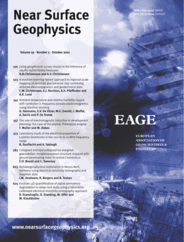
Full text loading...
 , Charles Sweeney2
, Charles Sweeney2
Glacial ice from the last major advance covered the state of Connecticut and reached its glacial maximum on Long Island ∼21,000 years ago. As glacial ice melted and retreated northward, meltwater streams deposited sediments, like gravel, sand, silt and clay, in low‐lying areas. Many periglacial lakes formed in central Connecticut as meltwater accumulated into valleys that were dammed by ice or glacial sediments. The Cromwell delta was deposited into glacial Lake Middletown. Previous studies have identified seven types of morphosequences, which are sedimentary facies that were deposited contemporaneously. The Cromwell delta is an ice‐marginal deltaic morphosequence, with proximal deposits laid atop stagnant glacial ice and distal deposits built up as free fronts in open waters of glacial Lake Middletown. Proximal deposits experienced collapse as stagnant ice blocks melted. Thus, each ice‐marginal deltaic morphosequence within the Cromwell delta includes two sections bounded by an east‐west‐trending topographic high delineating a previous ice‐margin position: north of this boundary are collapsed deltaic deposits dipping northward; south are non‐collapsed deltaic deposits dipping southward. Ground penetrating radar was used at River Highlands State Park to map sections of the Cromwell delta. The purpose of the study is threefold: (1) to demonstrate the capabilities of ground penetrating radar for identifying deltaic structures and locating previous ice‐margin positions; (2) to provide insight into the collapsed delta formation by examining the areal extent and geometry of collapsed structures; (3) to show how ground penetrating radar can be used in an exploratory manner, with limited access to direct subsurface data, by combining ground penetrating radar with shallow auger samples and results from previous studies in areas near River Highlands State Park, the Cromwell delta and other contemporaneous deltas. Results show that ground penetrating radar can be used to map deltaic morphosequences and ice‐marginal positions to provide a more detailed understanding of the Cromwell delta history at River Highlands State Park.

Article metrics loading...

Full text loading...
References


Data & Media loading...

